
The American bison (Bison bison), also commonly known as the American buffalo, is a North American species of bison that once roamed the grasslands of North America in massive herds. Their range once roughly comprised a triangle between the Great Bear Lake in Canada's far northwest, south to the Mexican states of Durango and Nuevo León, and east along the western boundary of the Appalachian Mountains Because of commercial hunting and slaughter in the 19th century, the bison nearly became extinct and is today restricted to a few national parks and reserves.
Two subspecies or ecotypes have been described: the plains bison (Bison bison bison), smaller in size and with a more rounded hump, and the wood bison (Bison bison athabascae) – the larger of the two and having a taller, square hump. Furthermore, it has been suggested that the plains bison consists of a northern (Bison bison montanae) and a southern subspecies, bringing the total to three. However, this is generally not supported. The wood bison is one of the largest species of bovid in the world, surpassed by only the Italian Chianina, the Asian gaur and wild Asian water buffalo. It is the largest extant land animal in North America.
Description
A bison has a shaggy, long, dark brown winter coat, and a lighter weight, lighter brown summer coat. As is typical in ungulates, the male bison are slightly larger than the female. Plains bison are often in the smaller range of sizes, and Wood bison in the larger range. Head-and-body length ranges from 2 to 3.5 m (6.6 to 11.5 ft) long, the tail adding 30 to 91 cm (12 to 36 in). Shoulder height in the species can range from 152 to 186 cm (60 to 73 in). Typical weight can range from 318 to 1,000 kg (700 to 2,200 lb). The heaviest wild bull ever recorded weighed 1,270 kg (2,800 lb). When raised in captivity and farmed for meat, the bison can grow unnaturally heavy and the largest semi-domestic bison weighed 1,724 kg (3,800 lb). The heads and forequarters are massive, and both sexes have short, curved horns that can grow up to 2 feet (61 cm) long, which they use in fighting for status within the herd and for defense.Bison are herbivores, grazing on the grasses and sedges of the North American prairies. Their daily schedule involves two-hour periods of grazing, resting and cud chewing, then moving to a new location to graze again. Bison mate in August and September; gestation is 285 days. A single reddish-brown calf nurses until the next calf is born. If the cow is not pregnant, a calf will nurse for 18 months. Bison cows are mature enough to produce a calf at 3 years of age. Bison bulls may try to mate with cows at 3 years of age, but if more mature bulls are present, they may not be able to compete until they reach 5 years of age. Bison have a life expectancy of approximately 15 years in the wild and up to 25 years in captivity.
For the first two months of life, calves are lighter in color than mature bison. One very rare condition is the white buffalo, in which the calf turns entirely white. White bison are considered sacred by many Native Americans.
Name
The term "buffalo" may be considered a misnomer for this animal, as it is only distantly related to either of the two "true buffalo," the Asian water buffalo and the African buffalo. However, "bison" is a Greek word meaning ox-like animal, while "buffalo" originated with the French fur trappers who called these massive beasts bœufs, meaning ox or bullock – so both names, "bison" and "buffalo," have a similar meaning. In reference to this animal, the term "buffalo," which dates to 1635, has a much longer history than the term "bison," which was first recorded in 1774. The American bison is more closely related to the wisent or European bison.
Skulls of European bison (left) and American bison (right)
Differences from European bison
Although they are superficially similar, the American and European bison exhibit a number of physical and behavioral differences. The American species has 15 ribs, while the European bison has 14. The American bison has four lumbar vertebrae, while the European has five.[dubious ] Adult American bison are not as rangy in build, and have shorter legs. American bison tend to graze more, and browse less than their European cousins, due to their necks being set differently. Compared to the nose of the American bison, that of the European species is set farther forward than the forehead when the neck is in a neutral position. The body of the American bison is hairier, though its tail has less hair than that of the European bison. The horns of the European bison point forward through the plane of its face, making it more adept at fighting through the interlocking of horns in the same manner as domestic cattle, unlike the American bison which favors charging. American bison are more easily tamed than their European cousins, and breed more readily with domestic cattle.Range and population
Despite being the closest relatives of domestic cattle native to North America, bison were never domesticated by native Americans. Later attempts of domestication by Europeans prior to the 20th century met with limited success. Bison were described as having "wild and ungovernable temper";[18] they can jump 6 feet vertically,and run 35–40 mph (56–64 kph) when agitated. In combination with their weight, that makes bison herds difficult to confine, because they can jump over or crash through almost any fence.There are approximately 500,000 bison in captive commercial populations (mostly plains bison) on about 4,000 privately owned ranches. Under the IUCN Red List Guidelines, commercial herds are not eligible for consideration in determining a Red List designation, therefore the total population of bison calculated in conservation herds is approximately 30,000 individuals and the mature population consists of approximately 20,000 individuals. Of the total number presented, only 15,000 total individuals are considered wild bison in the natural range within North America (free-ranging, not confined primarily by fencing).
As livestock
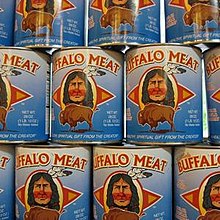
Bison meat for sale.

American bison Bison bison near Chihuahua City.
Recent genetic studies of privately owned herds of bison show that many of them include animals with genes from domestic cattle. For example, the herd on Santa Catalina Island, California, isolated since 1924 after being brought there for a movie shoot, were found to be mostly crossbreeds. It is estimated that there are as few as 12,000 to 15,000 pure bison in the world. The numbers are uncertain because the tests used to date – mitochondrial DNA analysis – indicate only if the maternal line (back from mother to mother) ever included domesticated bovines and thus say nothing about possible male input in the process. It was found that most hybrids look exactly like purebred bison; therefore, appearance is not a good indicator of genetics.
A proposal known as Buffalo Commons has been suggested by a handful of academics and policymakers to restore large parts of the drier portion of the Great Plains to native prairie grazed by bison. Proponents argue that current agricultural use of the shortgrass prairie is not sustainable, pointing to periodic disasters, including the Dust Bowl, and continuing significant human population loss over the last 60 years. However, this plan is opposed by some who live in the areas in question.
Behavior and ecology

A Bison bison galloping.
Horning
Bison mate in late spring and summer in more open plain areas. During fall and winter, bison tend to gather in more wooded areas. During this time, bison partake in horning behaviors. They will rub their horns against trees, young saplings and even telephone poles. Aromatic trees like cedars and pine seem to be preferred. Horning appears to be associated with insect defense as it occurs most often in the fall when the insect population is at its highest. Cedar and pines emit an aroma after bison horn them and this seems to be used as a deterrent for insects.Social behavior and reproduction
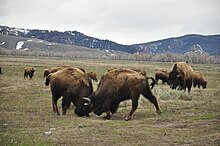
Bison fighting in Grand Teton National Park in Moose, Wyoming
Bison herds have dominance hierarchies that exist for both males and females. A bison's dominance is related to its birth date. Bison born earlier in the breeding season are more likely to be larger and more dominant as adults. Thus bison are able to pass on their dominance to their offspring as dominant bison breed earlier in the season. In addition to dominance, the older bison of a generation also have a higher fertility rate than the younger ones. Cows nurse their calves for at least 7 or 8 months but most calves seem to be weaned before the end of their first year.
Bison have been observed to display homosexual behaviors, males much more so than females. In the case of males, it is unlikely to be related to dominance but rather to social bonding or gaining sexual experience.
Wallowing behavior

An American bison standing its ground against a wolf pack
Predation
While often secure from predation due to their size and strength, in some areas, bison are regularly predated by wolves. Wolf predation typically peaks in late spring and early summer, with attacks usually being concentrated on cows and calves. Observations have shown that wolves more actively target herds with calves than those without. The length of a predation episode varies, ranging from a few minutes to over nine hours. Bison display five apparent defense strategies in protecting calves from wolves: running to a cow, running to a herd, running to the nearest bull, running in the front or center of a stampeding herd, and entering water bodies such as lakes or rivers. When fleeing wolves in open areas, cows with young calves take the lead, while bulls take to the rear of the herds, to guard the cows' escape. Bison typically ignore wolves not displaying hunting behavior. Wolf packs specializing in bison tend to have a greater number of males, as their superior size compared to the females allows them to wrestle their prey to the ground more effectively. The grizzly bear can also pose a threat to calves and sometimes adult bison, especially infirm specimens.Hunting
Native hunting
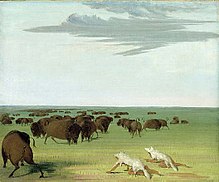
Bison hunt under the wolf-skin mask, 1832–33
Bison were a keystone species, whose grazing pressure was a force that shaped the ecology of the Great Plains as strongly as periodic prairie fires and which were central to the lifestyle of Native Americans of the Great Plains. However, there is now some controversy over their interaction. "Hernando De Soto's expedition staggered through the Southeast for four years in the early 16th century and saw hordes of people but apparently did not see a single bison," Charles C. Mann wrote in 1491: New Revelations of the Americas Before Columbus. Mann discussed the evidence that Native Americans not only created (by selective use of fire) the large grasslands that provided the bison's ideal habitat but also kept the bison population regulated. In this theory, it was only when the original human population was devastated by wave after wave of epidemic (from diseases of Europeans) after the 16th century that the bison herds propagated wildly. In such a view, the seas of bison herds that stretched to the horizon were a symptom of an ecology out of balance, only rendered possible by decades of heavier-than-average rainfall. Other evidence of the arrival circa 1550–1600 AD in the savannas of the eastern seaboard includes the lack of places which southeast natives named after buffalo. Bison were the most numerous single species of large wild mammal on Earth.

A bison hunt depicted by George Catlin.
To get the optimum use out of the bison, the Native Americans had a specific method of butchery, first identified at the Olsen-Chubbock archaeological site in Colorado. The method involves skinning down the back to get at the tender meat just beneath the surface, the area known as the "hatched area." After the removal of the hatched area, the front legs are cut off as well as the shoulder blades. Doing so exposes the hump meat (in the wood bison), as well as the meat of the ribs and the bison's inner organs. After everything was exposed, the spine was then severed and the pelvis and hind legs removed. Finally, the neck and head were removed as one. This allowed for the tough meat to be dried and made into pemmican.
Later, when Plains Indians obtained horses, it was found that a good horseman could easily lance or shoot enough bison to keep his tribe and family fed, as long as a herd was nearby. The bison provided meat, leather, sinew for bows, grease, dried dung for fires, and even the hooves could be boiled for glue. When times were bad, bison were consumed down to the last bit of marrow.
19th-century bison hunts
Bison were hunted almost to extinction in the late 19th century primarily by market hunters and were reduced to a few hundred by the mid-1880s. They were hunted for their skins, with the rest of the animal left behind to decay on the ground. After the animals rotted, their bones were collected and shipped back east in large quantities.The US Army sanctioned and actively endorsed the wholesale slaughter of bison herds. The US federal government promoted bison hunting for various reasons, to allow ranchers to range their cattle without competition from other bovines, and primarily to weaken the North American Indian population by removing their main food source and to pressure them onto the reservations. Without the bison, native people of the plains were forced either to leave the land or starve to death.

Paul Kane witnessed and participated in the annual bison hunt of the Métis in June 1846 on the prairies in Dakota.
The railroad industry also wanted bison herds culled or eliminated. Herds of bison on tracks could damage locomotives when the trains failed to stop in time. Herds often took shelter in the artificial cuts formed by the grade of the track winding through hills and mountains in harsh winter conditions. As a result, bison herds could delay a train for days.
The main or primary reason for the bison's near-demise, much like the actual demise of the passenger pigeon, was commercial market hunting.
Bison skins were used for clothing such as robes, rugs and, most importantly, for industrial machine belts. Prior to electrification factories were usually powered by a centrally located steam engine, with the power carried throughout the factory using an arrangement known as line shaft transmission. Power from the engine was transferred to rods suspended below the ceiling on each floor of the factory, where it was in turn transferred to individual machines on the floor via a leather belt running on two pulleys, one on the rod and the other on the machine. Buffalo leather was the material of choice for this application because of its strength and wear resistance.
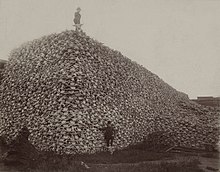
A pile of bison skulls in the 1870s.
The market hunter would customarily locate the herd in the early morning, and station himself about 100 metres (109 yd) from it, shooting the animals broadside through the lungs. Head shots were not preferred as the soft lead bullets would often flatten and fail to penetrate the skull, especially if mud was matted on the head of the animal. The bison would continue to drop until either the herd sensed danger and stampeded or perhaps a wounded animal attacked another, causing the herd to disperse. If done properly, a large number of bison would be felled at one time. Following up were the skinners, who would drive a spike through the nose of each dead animal with a sledgehammer, hook up a horse team, and pull the hide from the carcass. The hides were dressed, prepared, and stacked on the wagons by other members of the organization.
For a decade from 1873 on, there were several hundred, perhaps over a thousand, such commercial hide/market hunting outfits harvesting bison at any one time, vastly exceeding the take by American Indians or individual meat hunters. The commercial take arguably was anywhere from 2,000 to 100,000 animals per day depending on the season, though there are no statistics available. It was said that the Big .50s were fired so much that the market hunters needed at least two rifles to let the barrels cool off; The Fireside Book of Guns reports they were sometimes quenched in the winter snow. Dodge City saw railroad cars sent East filled with stacked hides.
The building of the railroads through Colorado and Kansas split the bison herd in two parts, the southern herd and the northern herd. The last refuge of the southern herd was in the Texas Panhandle.
As the great herds began to wane, proposals to protect the bison were discussed. Cody, among others, spoke in favor of protecting the bison because he saw that the pressure on the species was too great. Yet these proposals were discouraged since it was recognized that the Plains Indians, often at war with the United States, depended on bison for their way of life. In 1874, President Ulysses S. Grant "pocket vetoed" a Federal bill to protect the dwindling bison herds, and in 1875, General Philip Sheridan pleaded to a joint session of Congress to slaughter the herds, to deprive the Indians of their source of food. By 1884, the American bison was close to extinction.
Resurgence

American bison grazing in Custer State Park in South Dakota.
Simultaneously, two Montana ranchers, Michel Pablo and Charles Allard, spent more than 20 years assembling one of the largest collections of purebred bison on the continent (by the time of Allard's death in 1896, the herd numbered 300). In 1907, after U.S. authorities declined to buy the herd, Pablo struck a deal with the Canadian government and shipped most of his bison northward to the newly created Elk Island National Park.Also, in 1907, the New York Zoological Park sent 15 bison to Wichita Mountains Wildlife Refuge in Oklahoma forming the nucleus of a herd that now numbers 650.
The Antelope Island Bison Herd, an isolated bison herd on Utah's Antelope Island has also been used to improve the genetic diversity of American bison. The current American bison population has been growing rapidly, and is estimated at 350,000 compared to an estimated 60 to 100 million in the mid-19th century. Most current herds, however are genetically polluted or partly crossbred with cattle. Today there are only four genetically unmixed, free roaming, public bison herds and only one that is also free of brucellosis: it roams Wind Cave National Park. A founder population of 16 animals from the Wind Cave Bison Herd was re-established in Montana in 2005 by the American Prairie Foundation. The herd now numbers near 100 and roams a 14,000-acre (57 km2) grassland expanse on American Prairie Reserve.
The last of the remaining "Southern Herd" in Texas were saved before extinction in 1876. Charles Goodnight's wife, "Molly" encouraged him to save some of the last relict bison that had taken refuge in the Texas Panhandle. Extremely committed to save this herd, she went as far as to rescue some young orphaned buffaloes and even bottle fed and cared for them until adulthood. By saving these few plains bison, she was able to establish an impressive buffalo herd near the Palo Duro Canyon. Peaking at 250 in 1933, the last of the southern buffalo would become known as the Goodnight Herd. The descendants of this southern herd were moved to Caprock Canyons State Park near Quitaque, Texas in 1998.
Many other bison herds are in the process of being created or have been created in State Parks and National Parks, and on private ranches, with individuals taken from the existing main 'Foundation Herds'. An example is the Henry Mountains Bison Herd in Central Utah which was founded in 1941 with bison that were relocated from Yellowstone National Park. This herd now numbers approximately 400 individuals and in the last decade steps have been taken to expand this herd to the mountains of the Book Cliffs, also in Utah.
One of the largest privately owned herds, numbering 2,500, in the US is on the Tallgrass Prairie Preserve in Oklahoma which is owned by the Nature Conservancy. Ted Turner is the largest private owner of bison with about 50,000 on several different ranches.
The only continuously wild bison herd in the United States resides within Yellowstone National Park. Numbering between 3,000 and 3,500, the Yellowstone Park Bison Herd is descended from a remnant population of 23 individual 'mountain' bison that survived the mass slaughter of the 19th century by hiding out in the Pelican Valley of Yellowstone Park. In 1902, a captive herd of 21 plains bison was introduced to the Lamar Valley and managed as livestock until the 1960s, when a policy of natural regulation was adopted by the park.
The end of the ranching era and the onset of the natural regulation era set into motion a chain of events that have led to the bison of the Yellowstone Park Bison Herd migrating to lower elevations outside the park in search of winter forage. The presence of wild bison in Montana is perceived as a threat to many cattle ranchers, who fear that the small percentage of bison that carry brucellosis will infect livestock and cause cows to abort their first calves. However, there has never been a documented case of brucellosis being transmitted to cattle from wild bison. The management controversy that began in the early 1980s continues to this day, with advocacy groups arguing that the Yellowstone Park Bison Herd should be protected as a distinct population segment under the Endangered Species Act.
Bison hunting today
Hunting of wild bison is legal in some states and provinces where public herds require culling to maintain a target population. In Alberta, where one of only two continuously wild herds of bison exist in North America at Wood Buffalo National Park, bison are hunted to protect disease-free public (reintroduced) and private herds of bison.Bison hunting in Utah is permitted in both the Antelope Island Bison Herd and the Henry Mountains Bison Herd though the licenses are limited and tightly controlled. A Game Ranger is also generally sent out with any hunters to help them find and select the right bison to kill. In this way, the hunting is used as a part of the wildlife management strategy and to help cull less desirable individuals.
In Montana, a public hunt was reestablished in 2005, with 50 permits being issued. The Montana Fish, Wildlife, and Parks Commission increased the number of tags to 140 for the 2006/2007 season. Advocacy groups claim that it is premature to reestablish the hunt, given the bison's lack of habitat and wildlife status in Montana.
Bison were also reintroduced to Alaska in 1928, and both domestic and wild herds subsist in a few parts of the state. The state grants limited permits to hunt wild bison each year.
The bison is one of the few North American large game animals that can be hunted year round, though hunters prefer to hunt it at certain times of the year to achieve desired appearances of the coat.
In 2002 the United States government donated some buffalo calves from South Dakota and Colorado to the Mexican government for the reintroduction of bison to Mexico's nature reserves. These reserves included El Uno Ranch at Janos and Santa Helena Canyon, Chihuahua, and Boquillas del Carmen, Coahuila, which is located on the southern shore of the Rio Grande and the grasslands bordering Texas and New Mexico.
Genetics
Two of the major problems that bison face today are the genetic bottleneck and lack of genetic diversity that has been caused by the very small number of bison that survived their near extinction event. A second genetic problem is the entry of genes from domestic cattle into the bison population, through hybridization.Officially, the "American buffalo" is classified by the United States Government as a type of cattle, and the government allows private herds to be managed as such. This is a reflection of the characteristics that bison share with cattle. Though the American bison (Bison bison) is not only a separate species, but is usually regarded as being in a separate genus from Domestic cattle (Bos primigenius), they clearly have a lot of genetic compatibility and American bison can interbreed with cattle, although only the female offspring in the first generation are fertile. These female hybrids can be bred back to either bison or domestic bulls, resulting in either 1/4 or 3/4 bison young. Female offspring from this cross are also fertile, but males are not reliably fertile unless they are either 7/8 bison or 7/8 domestic. Moreover, when they do interbreed, crossbreed animals in the first generation tend to look very much like purebred bison, so appearance is completely unreliable as a means of determining what is a purebred bison and what is a crossbred cow. Many ranchers have deliberately cross bred their cattle with bison, and it would also be expected that there could be some natural hybridization in areas where cattle and bison occur in the same range. Since cattle and bison eat similar food and tolerate similar conditions, they have often been in the same range together in the past, and opportunity for cross breeding may sometimes have been common.
In recent decades tests were developed to determine the source of mitochondrial DNA in cattle and bison, and it was found that most private 'buffalo' herds were actually cross bred with cattle, and even most state and federal buffalo herds had some cattle DNA. With the advent of nuclear microsatellite DNA testing, the number of herds that contained cattle genes has increased. Though approximately 500,000 bison exist on private ranches and in public herds, some people estimate that perhaps only 15,000 to 25,000 of these bison are pure and are not actually bison-cattle hybrids. "DNA from domestic cattle (Bos taurus) has been detected in nearly all bison herds examined to date. Significant public bison herds that do not appear to have hybridized domestic cattle genes are the Yellowstone Park Bison Herd, the Henry Mountains Bison Herd which was started with bison taken from Yellowstone Park, the Wind Cave Bison Herd and the Wood Buffalo National Park Bison Herd and subsidiary herds started from it, in Canada.
A landmark study of bison genetics that was performed by James Derr of the Texas A&M University corroborated this. The Derr study was undertaken in an attempt to determine what genetic problems bison might face as they repopulate former areas, and it noted that bison seem to be doing quite well, despite their apparent genetic bottleneck. One possible explanation for this might be the small amount of domestic cattle genes that are now in most bison populations, though this isn't the only possible explanation for bison success.
In the study cattle genes were also found in small amounts throughout most national, state and private herds. "The hybridization experiments conducted by some of the owners of the five foundation herds of the late 1800s, have left a legacy of a small amount of cattle genetics in many of our existing bison herds." He also said, "All of the state owned bison herds tested (except for possibly one) contain animals with domestic cattle mtDNA." It appears that the one state herd that had no cattle genes was the Henry Mountains Bison Herd in the Henry Mountains of Utah. It is also notable that the Henry Mountain Herd was started initially with transplanted animals from Yellowstone Park. However, the extension of this herd into the Book Cliffs of Central Utah involved mixing the founders with additional bison from another source, so it is not known if the Book Cliff extension of the herd is also free of cattle hybridization.
A separate study by Wilson and Strobeck, published in Genome, was done to define the relationships between different herds of bison in the United States and Canada, and to determine whether the bison at Wood Buffalo National Park in Canada and the Yellowstone Park Bison Herd were possibly separate subspecies, and not plains bison. It was determined that the Wood Buffalo Park bison were actually cross breeds between plains bison and wood bison, but that their predominant genetic makeup was truly that of the expected "wood buffalo." However, the Yellowstone Park Bison Herd were pure plains bison, and not any of the other previously suggested subspecies. Another interesting finding was that the bison in the Antelope Island Bison Herd in Utah appeared to be more distantly related to other plains bison in general than any other plains bison group that was tested, though this might be due to genetic drift caused by the small size of only 12 individuals in the founder population. A side finding of this was that the Antelope Island Bison Herd appears to be most closely related to the Wood Buffalo National Park Bison Herd, though the Antelope Island bison are actually plains bison.
Bison trails
The first thoroughfares of North America, except for the time-obliterated paths of mastodon or muskox and the routes of the Mound Builders, were the traces made by bison and deer in seasonal migration and between feeding grounds and salt licks. Many of these routes, hammered by countless hoofs instinctively following watersheds and the crests of ridges in avoidance of lower places' summer muck and winter snowdrifts, were followed by the Indians as courses to hunting grounds and as warriors' paths. They were invaluable to explorers and were adopted by pioneers.Bison traces were characteristically north and south, but several key east-west trails were used later as railways. Some of these include the Cumberland Gap through the Blue Ridge Mountains to upper Kentucky. A heavily used trace crossed the Ohio River at the Falls of the Ohio and ran west, crossing the Wabash River near Vincennes, Indiana. In Senator Thomas Hart Benton's phrase saluting these sagacious path-makers, the bison paved the way for the railroads to the Pacific.
Bison as a symbol
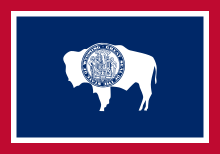
Wyoming uses a bison in its state flag.
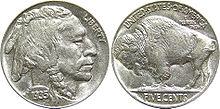
The 1935 Buffalo nickel – this style of coin featuring an American bison was produced from 1913 to 1938.

American bison on the obverse of the 1901 $10 bill.

First
postage stamp with image of bison was issued US in 1898 – 4c "Indian
Hunting Buffalo". Part of the Trans-Mississippi Exposition commemorative
series.
Several American coins feature the bison, most famously on the reverse side of the "buffalo nickel" from 1913 to 1938. In 2005, the United States Mint coined a nickel with a new depiction of the bison as part of its "Westward Journey" series. The Kansas and North Dakota state quarters, part of the "50 State Quarter" series, each feature bison. The Kansas state quarter has only the bison and does not feature any writing, while the North Dakota state quarter has two bison. The Yellowstone National Park Quarter also features a bison standing next to a geyser.
Other institutions which have adopted the bison as a symbol or mascot include:
- U.S. Department of the Interior
- Bethany College (West Virginia)
- Bucknell University
- Buffalo, New York
- Buffalo Bills
- Buffalo Bisons
- Buffalo Bulls
- Buffalo Grove High School
- Buffalo Sabres
- University at Buffalo, The State University of New York
- USS Buffalo submarine
- University of Colorado
- Gallaudet University
- Harding University
- Howard University
- Seal of the State of Indiana
- Lipscomb University
- Coat of Arms of Manitoba
- Flag of Manitoba
- University of Manitoba
- Marshall University
- Milligan College
- Independence Party of Minnesota
- Ralph Nader (mascot for his 2008 campaign for president)
- Nichols College
- North Dakota State University
- Oklahoma Baptist University
- Royal Canadian Mounted Police
- Southwestern Law School
- CFB Wainwright
- West Texas A&M University
- Tooele High School, Tooele, UT
- The Regional Municipality of Wood Buffalo, Alberta
Dangers
Bison are among the most dangerous animals encountered by visitors to the various U.S. and Canadian national parks, and will attack humans if provoked. They appear slow because of their lethargic movements but can easily outrun humans – bison have been observed running as fast as 35–40 miles per hour (56–64 km/h). Bison are more agile than one might expect, given their size and body structure.Between 1980 and 1999, more than three times as many people in Yellowstone National Park were injured by bison than by bears. During this period, bison charged and injured 79 people, with injuries ranging from goring puncture wounds and broken bones to bruises and abrasions. Bears injured 24 people during the same time frame. Three people died from the injuries inflicted – one person by bison in 1983, and two people by bears in 1984 and 1986.
No comments:
Post a Comment